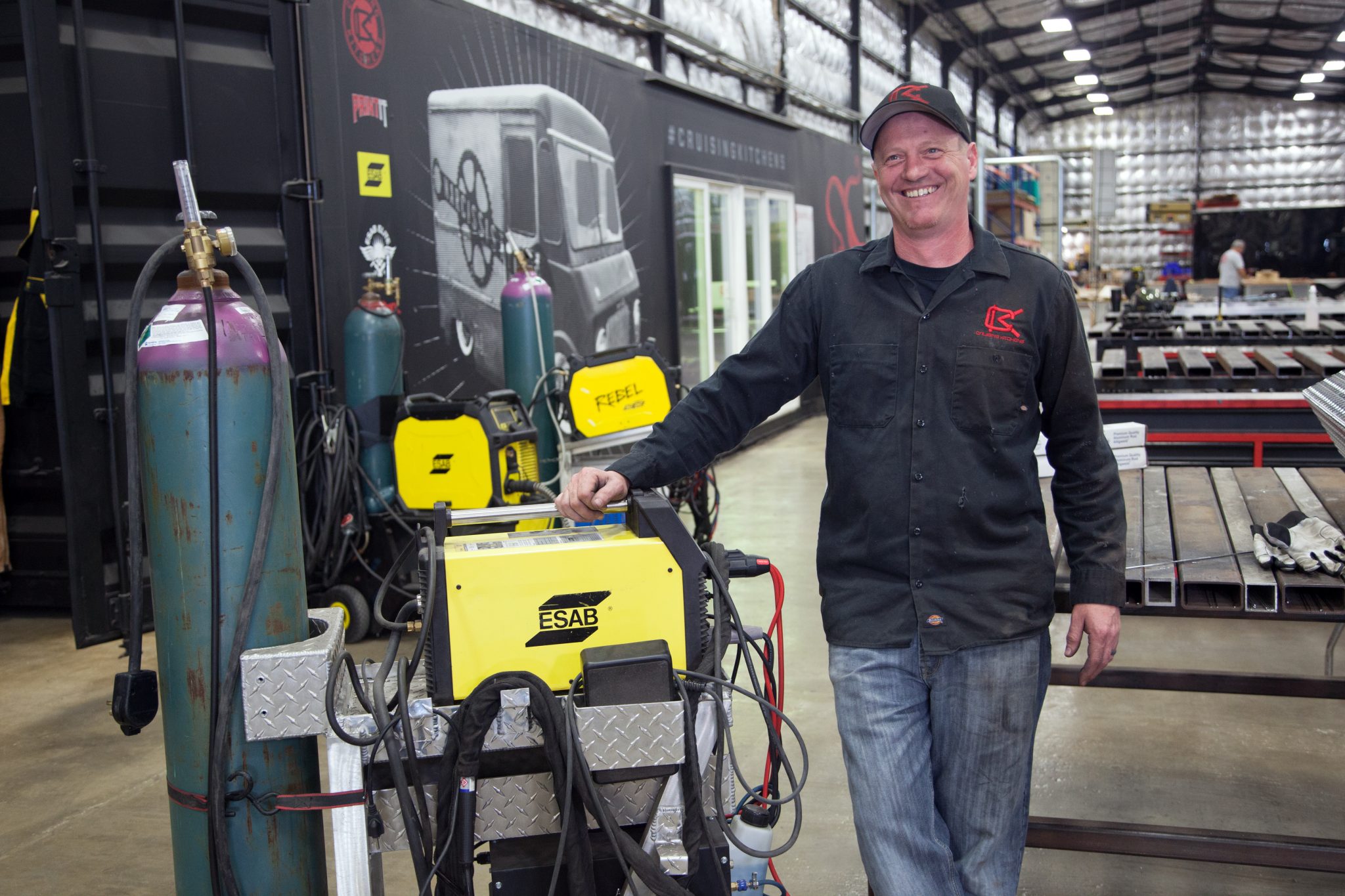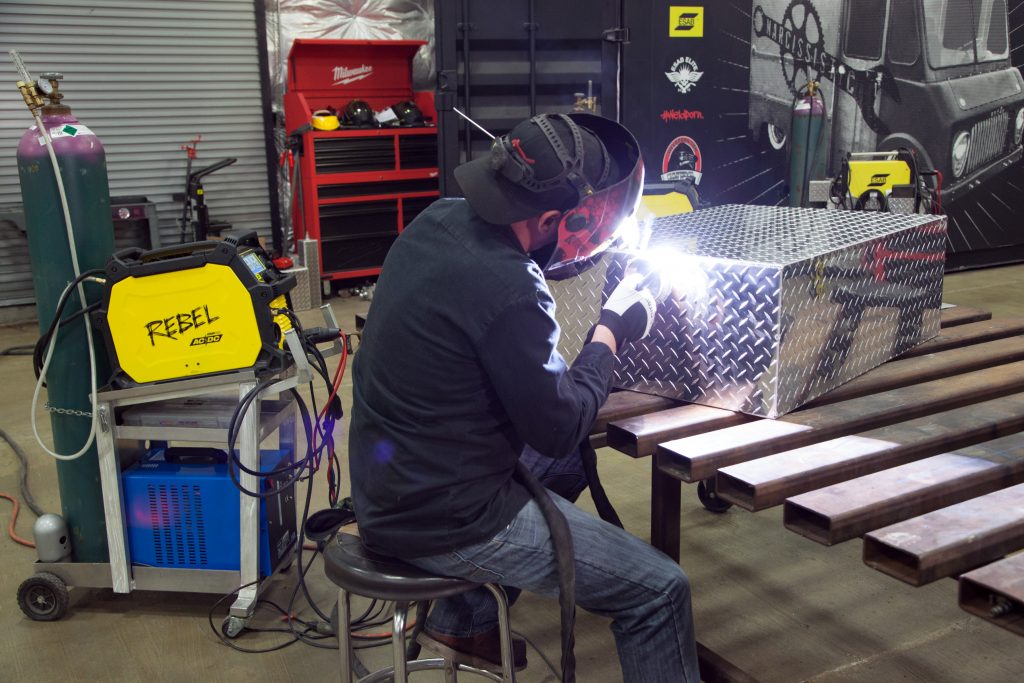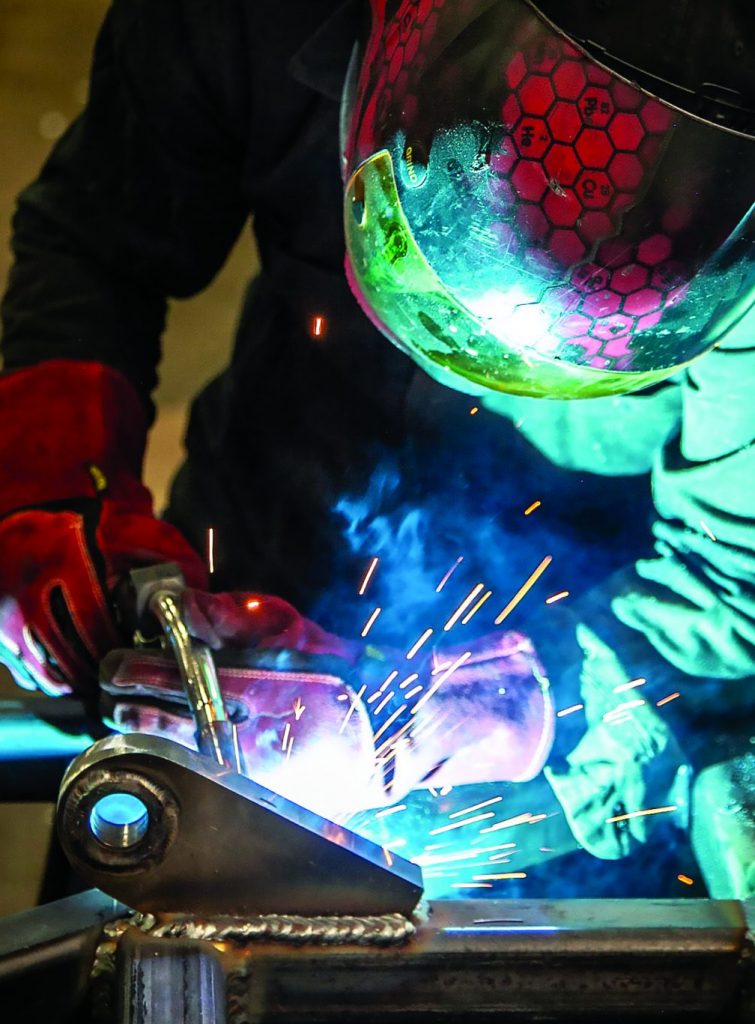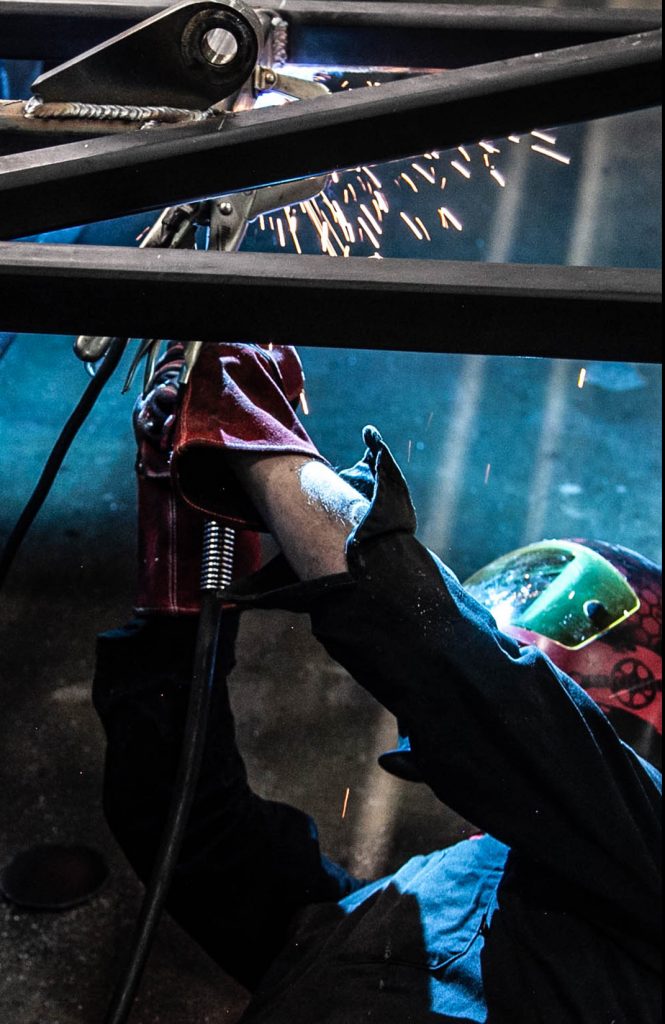
No surprise that there’s a flourishing bandwagon of people jumping from brick and mortar businesses into mobile products and services: offices, restaurants, shelters, vendors of any kind. If you can put it on wheels, chances are Cruising Kitchens, San Antonio, Texas, has built it. In fact, Cruising Kitchens probably built the bandwagon.
“Six years ago, our president and CEO, Cameron Davies, built his first food truck right before the big boom in the Austin and San Antonio area,” says James Flatman, shop manager, Cruising Kitchens. “He got his feet wet in the market before it really took off. There have been a lot of competitors that have come and gone, but Cruising Kitchens has just continued to grow.” And grow it has. In the last year and a half, the shop went from 10,000 sq. ft. to 68,000 sq. ft. and 70 employees located in a shop minutes from the San Antonio airport.
“We’re dealing with step vans, trailers, intermodal shipping containers, and each truck has a mix of stainless steel, aluminum and structural steel,” says Flatman. “From the fabrication side, we have MIG, Stick and TIG going into every truck.”
Making it Happen
Especially in the food truck industry, social media makes the difference between a cult-like following and a lonely parking lot. These small businesses owners need to inform their customers about where they’ll set up for the day, as well as promote daily specials.
For Cruising Kitchens, on the other hand, social media allows customers to see the build process along the way. In addition, they have an open-door policy. Customers can come in to see their product being built, fabricated and put together. Those who are out of state or the country get the same experience on social media.
The company works with high profile customers like the U.S. Army and renowned chef, restaurateur and T.V. personality Gordon Ramsey and understands the value of exposure.

“Being in a bigger facility opens up the capabilities of what we’re able to produce, and people can see that,” says Flatman. “We built Gordon Ramsey’s Hell on Wheels unit for his T.V. show, 24 Hours to Hell and Back, and we’re working with the U.S. Army so they can provide healthier eating options for the troops.”
Hell on Wheels is more than a mobile kitchen; it’s an extraordinarily well-equipped hi-tech rig built to go anywhere.
“It started off as a 30-ft. shipping container mounted to a lowboy trailer,” says Flatman. “It has a hydraulically-controlled stage and awning as well as an 18-ft.-wide by 8-ft.-high jumbotron on the roof. It’s all on one pendent operated by one pump, so they can pull up to wherever they need to be and set it up in five minutes with two people.”
The inside has two complete state-of-the-art kitchens. The back half is multi-purpose; the box on the back can be a command center for audiovisual equipment or, by pulling out the computer hardware, it becomes a walk-in cooler just by turning the refrigeration unit on. The hydraulic pump and electrical panel generator are held in the front box — the heart of the unit. There are also two 55-in. flat screen televisions, one on each side of the jumbotron, for playing additional footage. “It’s definitely a take-anywhere setup that draws a big crowd,” says Flatman.
In addition to building mobile kitchens, Cruising Kitchens builds dining halls for oil fields and rigs for colleges, zoos, food banks and nightclubs. Weight Watchers recently commissioned Cruising Kitchens for a unit that went on tour with DJ Khaled.
“We’re at a point where if a customer can come up with an idea, we are capable of making it happen,” says Flatman.
For completing rigs and putting on the finishing touches, Cruising Kitchens has upholstery, maintenance and printing shops on site. If a truck is used, it gets a full once over in the maintenance shop before a build begins. Interiors can be re-upholstered to match company logos, and at the print shop, trucks are wrapped with vinyl after design and printing are completed.
 Vehicle wraps may be simple or could contain color-changing vinyl placed over graphics that are printed on clear vinyl. Graphics for signs, storefronts, tradeshows and more are printed on a flatbed printer that can print a 4- by 8-ft. sheet of plastic, aluminum or stainless in about 90 seconds. The company offers a complete marketing package that includes t-shirts and hats.
Vehicle wraps may be simple or could contain color-changing vinyl placed over graphics that are printed on clear vinyl. Graphics for signs, storefronts, tradeshows and more are printed on a flatbed printer that can print a 4- by 8-ft. sheet of plastic, aluminum or stainless in about 90 seconds. The company offers a complete marketing package that includes t-shirts and hats.
Luxury Lives in the Finest Details
Cruising Kitchens is always up for a challenge. Bidding against other companies only strengthens its range of build and fabrication capabilities.
“What set up apart from the other companies in contention for Hell on Wheels was the hydraulic system for the stage and awning and the jumbotron itself,” says Flatman. “Other companies weren’t comfortable dealing with these things. We like a challenge and are not scared of trying something new.”
Perhaps its largest advantage over competitors is the company’s attention to detail. Flatman attributes much of this to his sheet metal workers and fabricators.
“They go above and beyond to make sure seams are flawless and we don’t have to caulk gaps. Everything meets up as it should, or they start over. They take pride in their work and it shows in the end product.”
Mobile Flexibility
To support employee craftsmanship in the new shop, Cruising Kitchens expanded its fleet of welding equipment, converting from heavier single-process units to compact, portable inverters from ESAB. Equipped added includes six Rebel™ EMP 235ic multiprocess (250-amp MIG-Stick-DC TIG) units, two Rebel EMP 205ic AC/DC all-process units. one ET 220i AC/DC TIG/Stick unit for larger TIG aluminum projects (e.g., long welds on ¼-in. material) and a Thermal Dynamics® Cutmaster® 60i manual plasma cutter.
Mounted on carts with cylinder racks, the inverters units quickly wheel from one end of the shop to the other, while their lightweight (even the 250-amp units only weigh 53 lbs.) allows the welder-fabricator to carry the unit inside a truck or container if needed.
“We’re not having to forklift bigger units into place or move units over to a person’s area,” says Flatman. “Also, a guy can knock out some stainless steel trim, then bounce over to another unit to weld out an aluminum water tank and then move over to a shipping container for structural steel work on the inside.”
Prior to moving into the larger space, Cruising Kitchens landed a big contract for a shipping container build, for which the company contemplated purchasing separate MIG and TIG welders in order to complete the project on time. However, Flatman had heard about Rebel’s multi-process capabilities.
“We inquired about the Rebel welders and got a response in 30 minutes,” says Flatman. “At the time, ESAB was really the only company that had a true multi-process machine.”
 While compact multiple process inverters had been available, they sacrificed performance in one or more modes or with different types of Stick electrodes (e.g., they could run an E7018 or an E6010 acceptably, but not both).
While compact multiple process inverters had been available, they sacrificed performance in one or more modes or with different types of Stick electrodes (e.g., they could run an E7018 or an E6010 acceptably, but not both).
Cruising Kitchens brought in the multi-process welder and were “blown away by it,” says Flatman.
“Rebel MIG welds beautifully, the TIG side of it is phenomenal, and Stick welding is even better,” says Flatman. “It runs so quietly when you’re Stick welding, you question whether it’s on until you get used to it.”
Cruising Kitchens met its needs for a heavier TIG aluminum with the ET 220i, which has a 200-amp output at 45 percent duty cycle on 1-ph primary power. A water-cooled torch enables continuous welding while keeping the torch comfortable, while ability to adjust AC output frequency and balance control keeps the arc focused.
“It’s hands down one of the nicest TIG machines I’ve used on aluminum because of its arc control,” says Flatman.
In addition, the Cruising Kitchen recently added two all-process Rebel 205s, which adds AC TIG capabilities for aluminum, as well as DC TIG, Stick, MIG and Flux-Cored capabilities.
“When you have guys who are TIG welding aluminum water tanks but also MIG welding framework for generators and Stick welding framework for shipping containers, it’s nice that they have their own machine to roll around the shop,” says Flatman. “It gives them ownership to knock out any job thrown at them.”
Equipment investment aside, the process of switching out machines and learning new products and setup has been relatively simple. “The machines are incredibly user-friendly. The big digital display on the front walks you through everything,” says Flatman. “We’ve had very few questions or concerns.”
About ESAB
ESAB is a world leader in the production of welding and cutting equipment and consumables. Their innovative, world-renowned equipment and solutions are developed with input from their customers and built with the expertise and heritage of a global manufacturing leader.








































